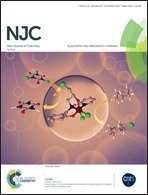The application of a bee glue-modified sensor in daclatasvir dual effect detection†
Abstract
A simple and novel carbon paste sensor containing chemically mixed propolis (bee glue) and graphene oxide (GO) was prepared, then electrochemical deposition of silver nanoparticles (AgNPs) was performed to fabricate a selective and sensible electrochemical sensor to detect Daclatasvir (DAC). This drug was newly approved in July 2015 as an essential medicine for Hepatitis C in the USA. A limited study was performed on this drug. The modified synthesized sensor has been characterized by scanning electron microscopy (SEM), energy dispersive X-ray (EDX) analysis and electrochemical experiments. The SNMGOPE (silver nanoparticles modified graphene oxide carbon paste electrode) gives a high electrocatalytic activity for 1.0 mM DAC oxidation in Britton Robinson (BR) buffer of pH = 2.0. The change in DAC concentration (2.5 × 10−8 to 1.2 × 10−5 M) was investigated against current, at 10 mV s−1, using differential pulse voltammetry (DPV), giving a detection limit of 1.599 nM. Improvement in the electron transfer process and a decrease in charge transfer resistance were detected. This created a sensor that effectively analyzes DAC concentration in real samples, such as pharmaceutical formulations and human urine samples.



 Please wait while we load your content...
Please wait while we load your content...